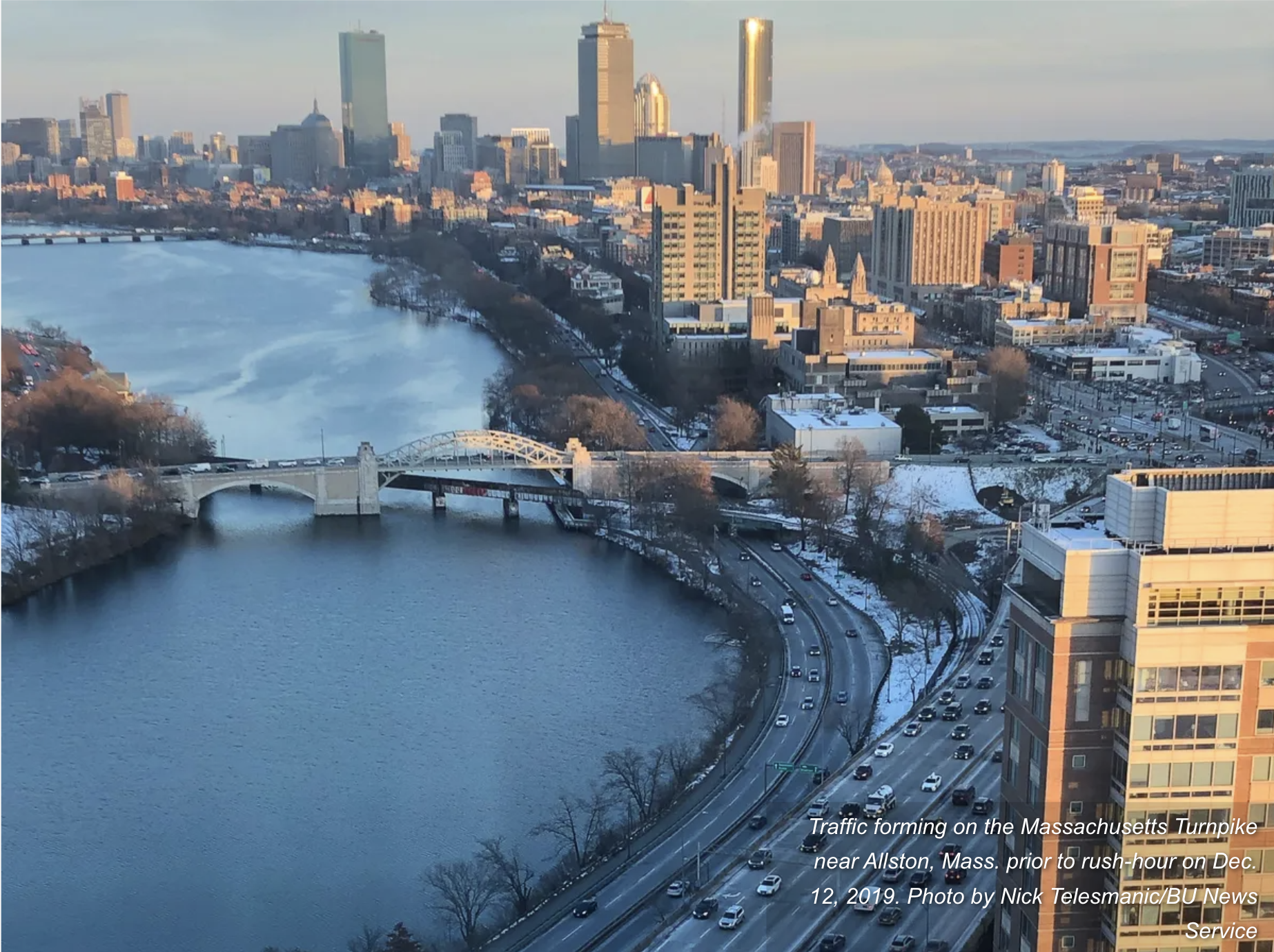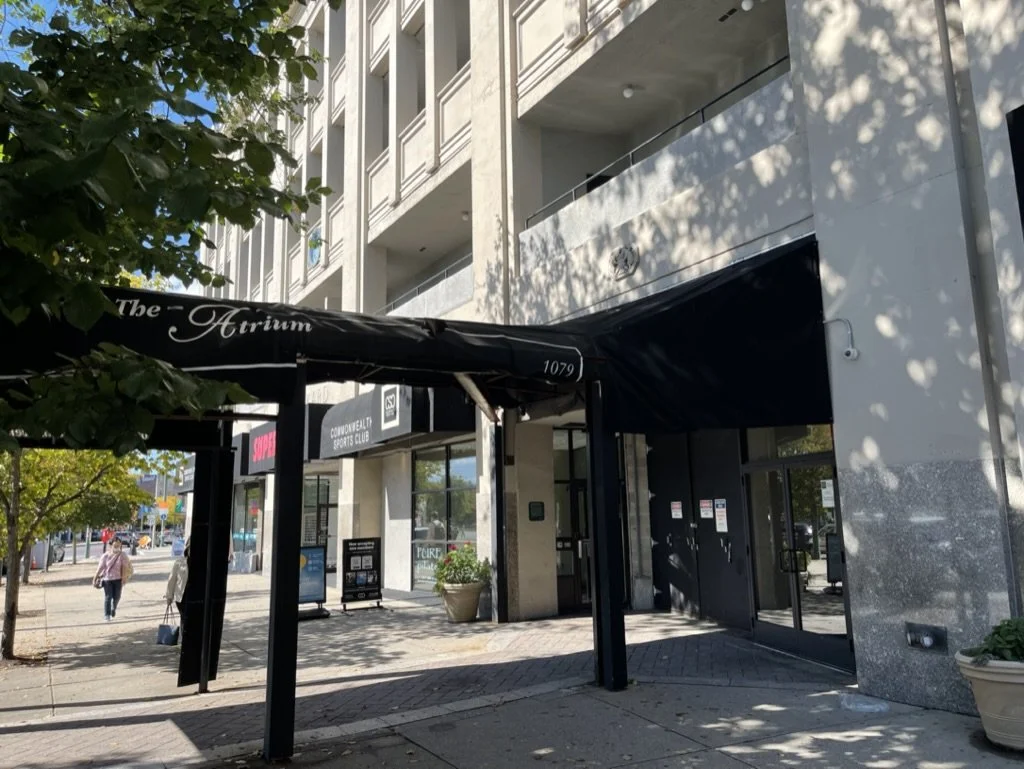BU News Service: Gentrification in Allston
Published in Boston University News Service on December 19, 2022; By Pamela Sari, Marja Koos, Shiyang Yi
Rising rent, rodent problems, construction at every turn, and streams of college students running late into the night bring to mind the West Boston neighborhood of Allston. With Harvard and other international developers vying for the untapped potential of the land, and the transient nature of the students and young professionals who make up a large portion of the community, Allston is undergoing significant changes and significant gentrification.
The Atrium 1079 Commonwealth Ave, an apartment for many students nearby, is dilapidated. Over the past two years, it has undergone several repairs aimed at modernizing the decades-old building. (Photo taken by Jintao Zhai)
American University Public Policy Professor Derek Hyra says gentrification can be seen visually through the establishment of new businesses, demographic shifts, economic transitions, resident education levels and real estate development.
“Bike lanes, dog parks, beer gardens, wine bars, third and fifth-wave coffee shops, luxury condos, luxury rentals, and posh restaurants – those are some of the visual symbols,” said Hyra. “It can be an influx of upper-income people to a low-income space, but it also can be an influx of capital.”
A 12-year Allston resident who asked not to be named said she has seen signs of gentrification since first moving in, but has seen it get worse over the years.
“It was very livable. You could tell by the shops in the area that there were things here that catered to all incomes, not just rich people,” she said. “And all that stuff is disappearing.”
She said Allston had become a “food desert” with specialty shops replacing an affordable grocery store in her community in Lower Allston. She also mentioned the lack of a post office within her vicinity. She said it appears like the area now caters only to people with cars.
“Then you’ve got the predator landlords, which just really do not help that matter at all,” she said. “They want college students because college students are young and tend to be clueless.”
According to data collected by the Boston Planning & Development Agency, 65% of Allston’s population is between the ages of 20-34. A leasing consultant in Allston, who only wanted to be mentioned as Aissa, said that more than 50% of residents in her managed property are college students.
“Allston is a really active and young neighborhood,” said Aissa. “If you live here, you will be surrounded by young people.”
The 40 Malvern St. Apartments, owned by the Hamilton Company, is located within two blocks of BU’s west campus.
(Photo taken by Jintao Zhai)
Michael Wu, who graduated from Boston University in May 2022, lived in Allston for 3 years.
“I lived in Allston almost my entire college life. It’s super convenient, the green line goes right to BU central, and there are lots of great places to go nearby,” said Wu.
Talking about the drawbacks of living in Allston, Wu pointed out a potential safety issue, which was his primary reason for moving away after his graduation.
“I used to see a crowd of people gather around a large truck, especially at night, in the parking lot in front of my house,” said Wu. “It frightened me so much that I tried not to go out at night after that.”
Frida Lin, who moved in during the pandemic and renewed her lease for 2022, said the rental price in Allston has increased a lot in the past year.
“The monthly rent of my apartment is nearly $3,000 now, but I rented it for only $2,000 during the pandemic in 2020,” said Lin.
88 Gardner St., a Hamilton Company property in Allston. (Photo taken by Jintao Zhai)
Boston Pads, an online realty platform, predicted a rent price increase of up to 7% in 2022 for Allston in their Apartment Rental Report. The report said rent prices would increase as a result of high inflation, rising interest rates following the COVID-19 pandemic, building materials, labor, and setbacks from other pandemic related setbacks. .
Hyra said the COVID-19 pandemic impacted gentrification in two ways. Economically, disparities between low-income and high-income jobs affected people’s ability to sustain households, he said. The other impact was on real estate. Apart from the moratorium on evictions, low-interest rates made developments easier to initiate during the pandemic, according to Hyra.
“Another visual symbol in areas that are gentrifying – you see cranes, you see development, you see construction going on,” said Hyra. He said displacement as a result of construction is another problem residents could face.
Cindy Marchando owns a two-story home in Allston and has lived in the neighborhood since 2006. She said construction and the price of homes going up has made it challenging for her as a homeowner.
“Living in the neighborhood has become very challenging, even for a homeowner,” said Marchando. She said vibrations from construction projects is a problem she shares with other homeowners around her.
“Every time we turn around it’s like a $20,000 to $40,000 fix, and there is no resource for us,” said Marchando. “We are experiencing abnormal wear and tear, and it is now becoming not affordable because you have increased costs.”
Marchando said she wants to see the City of Boston take proactive measures for homeowner issues, in addition to their commitment to affordable housing. She suggested a “construction litigation committee” to oversee problems with construction, similar to the Rent Stabilization Advisory Committee Mayor Wu established in May of 2022.
The Rent Stabilization Advisory Committee makes recommendations to Mayor Wu and the Mayor’s Office of Housing in order to stabilize Boston rents and avoid tenant displacement, according to the Mayor’s Office of Housing.
“Having some oversight, someone permanently having oversight of the area, can help mitigate some of this,” said Marchando. “I would like to see a fund set up for homeowners like me where I can request loans to be able to maintain my property because over time if you let things go, things get worse and worse and your property will not be livable.”
Hyra said there is nothing inherently wrong with institutional investment in itself, but questions arise when it comes to what the city is doing. He said residents should question what the city and institutions are truly doing when they develop construction projects in their neighborhoods.
With concerns rising for almost every aspect of life in Allston, what can residents do?
Hyra said Allston can look to other communities in Boston for lessons. He referred to the Dudley Street Neighborhood Initiative, a movement he uses when teaching gentrification and equitable development.
The Dudley Street Neighborhood Initiative was a grassroots community organization that emerged in response to disinvestment, arson, and trash dumping in the Roxbury area in the 1980s. The organization gained eminent domain authority, which allowed them to buy land and create affordable housing for the community. The organization is still serving Dudley residents.
“They have to organize. There has to be community mobilization to try to advocate for rent stabilization or for affordable housing,” said Hyra.
Allston Village Main Streets (AVMS) is a nonprofit centered around business development and works to improve the vitality, diversity, and vibrancy of the local community and culture.
The organization has four core goals: to increase Allston’s accessibility for all forms of transportation, to grow the diversity of local businesses, to maintain a safe social scene, and to celebrate and uplift Allston residents of all backgrounds, according to the organization’s site.
1047 Commonwealth Ave. This apartment is affiliated with multiple colleges in Boston, including BU. It caters to students’ need for close-to-campus housing. (Photo taken by Jintao Zhai)
Reclaim Rock City, an organization that frequently works with AVMS to secure grants and host events, is trying to do just that. The group’s main goal is to “campaign for a more liveable Allston,” according to group member and community organizer Myles Taylor. The group holds weekly meetings in Allston’s Ringer Park where they discuss what could be done to improve conditions in their community and to spread awareness of the issues faced there.
RRC hosted park cleanups and community fairs to show the community what is possible. “We’re seeing proof that people do care a lot,” said Taylor. “They just don’t have the resources to care properly.”
He said landlords aren’t putting money back into their tenants, speaking of his five years of living in the neighborhood. “Predatory landlords are one of the biggest problems here,” he said. They’re effectively “letting these buildings rot,” he added.
Taylor’s roommate, Jackie Barnes, started a tenant union at a building owned by Samia, one of the largest landlords in Allston. The union was able to make demands and work with the building to fix issues and meet their needs.
“The art and music scene is the most obvious thing that is dying because we see spaces physically disappearing over time, such as Great Scott,” said Taylor. “People are trying to take over these spaces and create new opportunities, but they can’t raise the capital to do so.”
Landlords and banks are replacing these historic venues and gathering spaces with more profitable, less community-focused spaces. This allows them to “maintain the feeling of isolation they feel they can create in Allston, because it’s just college students, it’s just frat houses. No, it’s communities – we have neighbors,” Taylor added.
The Sound Museum, an affordable practice space for local bands, is set to be demolished and replaced with a life science research lab in the near future. Taylor and other members of the community campaigned against the development to no avail. “It’s going to raise rents and make it impossible to commute,” said Taylor. “It’s going to hurt so many different members of the community, and they just don’t care.”
Even with the changing landscape of his neighborhood, Taylor has no plans to leave. “I would live here forever if I could,” he said. “I would buy my house here, but I don’t know if that’s feasible for the future,” adding that every property owner he knows in the area bought their home years ago.
“It just feels safe to be queer here,” he added. “I feel comfortable walking down the street here and that’s not true of everywhere in Boston – that’s not true of everywhere in the country.”





